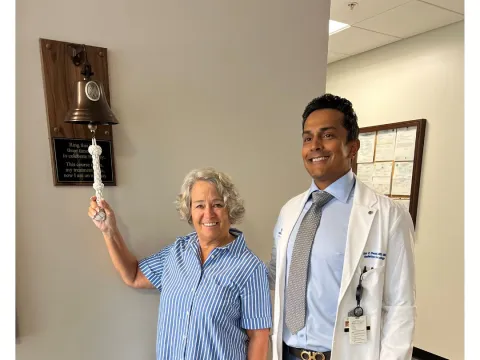- AdventHealth

After a routine eye exam, your physician notices some retinal damage and tells you it’s time to get tested for Type 2 diabetes. How can your provider know you have diabetes just by checking your eyes?
With Type 2 diabetes, your body does not respond properly to insulin. Insulin is a hormone produced by the pancreas that helps convert sugar in the blood into energy. When you become insulin resistant, sugar builds up in the blood instead of being used by your cells.
To check for diabetes, your physician will perform one or more tests to measure the amount of glucose (sugar) in your blood. An A1C test provides doctors with insight into your average blood glucose level during a two- or three-month period. A fasting plasma glucose test determines how much glucose is in your blood after fasting for at least eight hours. The oral glucose tolerance test (which is familiar to pregnant women) involves testing glucose levels both before and two hours after you drink a very sweet drink.
Slowly but Surely
Insulin resistance and Type 2 diabetes don’t happen overnight. Many people develop diabetes over a number of years, as their body slowly becomes more and more resistant to insulin. As more sugar builds up in the body over time, the amount of damage done gets worse.
Over time, high blood sugar can damage your heart, eyes, kidneys and nerves. The longer your blood sugar is uncontrolled, the worse the damage can get.
Taking Control
The good news is you can prevent complications from diabetes by controlling your blood sugar. Because damage from diabetes can take years, it’s important to make sustainable lifestyle changes. To control your sugar over time, use these tips:
- Get educated. Talk to your physician about resources in your area for diabetes education. Usually covered by insurance, these classes offer comprehensive information about diabetes, preventing problems and glucose control. The more you know, the more you can make smart, healthy choices.
- Make more movement. Regular exercise helps lower your blood sugar without medicine, increases blood flow, and can help burn extra calories and fat. Before changing your exercise routine, talk to your provider.
- Eat smart. Having diabetes doesn’t mean never eating cake or chocolate again. However, a balanced diet is key to good sugar control. Talk to your doctor about how much fat, protein and carbohydrates you should be getting every day.
- Check your sugar. With an at-home glucose monitor, you can know your blood sugar level with just a prick of a finger. Set a testing schedule so you know what’s normal for you and how well your treatment plan is working.
- Manage medications. There are oral pills and injectable insulin available for patients with diabetes who need help controlling their blood sugar.
For more information about Type 2 Diabetes, talk to our diabetic educator at Call863-419-1677. Learn about our diabetes support group here.
Recent News

AdventHealth debuts first-of-its-kind Performer Health Program in Central Florida
AdventHealth is launching the Performer Health Program, a first-of-its-kind initiative in Central Florida focused on addressing the unique health needs of artists and performers.

AdventHealth Waterman strengthens access to expert specialty care with expansion of Mount Dora medical plaza
Second floor buildout adds orthopedics, sports medicine, women’s health and heart care for Lake County

Expanding hope through innovation: AdventHealth advances cancer care across East Florida
Cancer touches nearly every family, and in Flagler, Lake and Volusia counties, the demand for timely, advanced care keeps rising. AdventHealth’s East Florida Division, which includes seven hospitals...

For two Hope Clinic patients, music spurs recovery
STROKESTRA heals stroke survivors in so many meaningful ways.

A new chapter begins: AdventHealth Avista opens its on-campus surgery center
This milestone marks a meaningful new chapter for a team whose history stretches back more than two decades.

AdventHealth Porter Performs Rare, Complex Robotic Kidney Cancer Surgery
AdventHealth Porter has reached an extraordinary milestone in surgical innovation, completing what is believed to be the first robotic left radical nephrectomy with inferior vena cava (IVC)...

Amanda Robinson, DO, joins AdventHealth Medical Group Family Medicine, Internal Medicine & Pediatrics at Curtis Parkway
AdventHealth is pleased to announce that Amanda Robinson, DO, has joined AdventHealth Medical Group Family Medicine, Internal Medicine & Pediatrics at Curtis Parkway.

Helping the Helpers: Spotlight on AdventHealth Avista’s Director of Supply Chain, Mike Vos
For Mike Vos, Director of Supply Chain at AdventHealth Avista, caring for others isn’t just part of the job - it’s woven into his family story. With a mother who is a career nurse and now Director of...

New hospital brings world-class, whole-person care to Minneola
AdventHealth Minneola will bring nationally recognized care close to home in South Lake County.

New surgeon expands local access to advanced colorectal care in Volusia County
Dr. Mark Heimberger joins AdventHealth as part of its continued investment in bringing minimally invasive and robotic colorectal treatment options to the region’s growing community.

Delivering on the mission: AdventHealth Supply Chain and Business Services' impact is part of every patient story
Every day, more than 1,500 Supply Chain and Business Services team members work behind the scenes with more than 3,000 suppliers to support how AdventHealth patients receive care.

Albit Paoli, MD joins AdventHealth Medical Group Orthopedics & Sports Medicine
AdventHealth is pleased to announce that Albit Paoli, MD, has joined AdventHealth Medical Group Orthopedics & Sports Medicine at Calhoun and AdventHealth Medical Group Orthopedics & Sports Medicine at...
